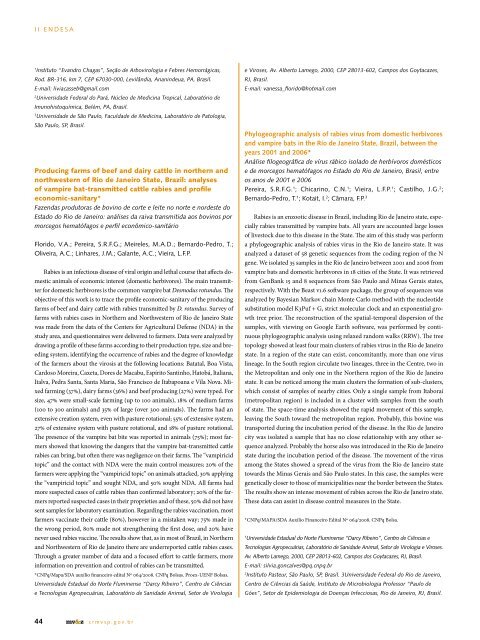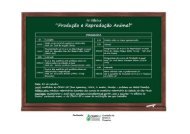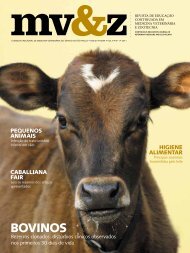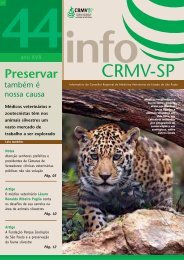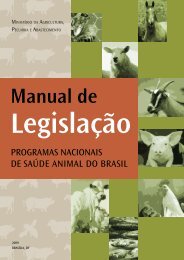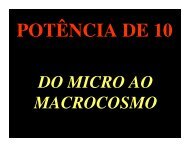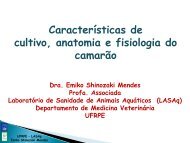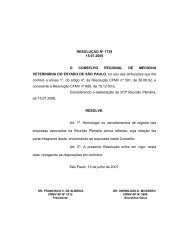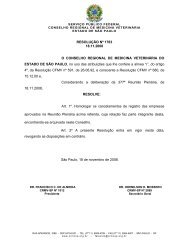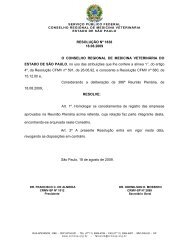I I e n d e s a1Instituto “Evandro Chagas”, Seção de Arbovirologia e Febres Hemorrágicas,Rod. BR-316, km 7, CEP 67030-000, Levilândia, Ananindeua, PA, Brasil.E-mail: liviacasseb@gmail.com2Universidade Federal do Pará, Núcleo de Medicina Tropical, Laboratório dee Viroses, Av. Alberto Lamego, 2000, CEP 28013-602, Campos dos Goytacazes,RJ, Brasil.E-mail: vanessa_florido@hotmail.comImunohistoquímica, Belém, PA, Brasil.3Universidade de São Paulo, Faculdade de Medicina, Laboratório de Patologia,São Paulo, SP, Brasil.Producing farms of beef and dairy cattle in northern andnorthwestern of Rio de Janeiro State, Brazil: analysesof vampire bat-transmitted cattle rabies and profileeconomic-sani tary*Fazendas produtoras de bovino de corte e leite no norte e nordeste doEstado do Rio de Janeiro: análises da raiva transmitida aos bovinos pormorcegos hematófagos e perfil econômico-sanitárioFlorido, V.A.; Pereira, S.R.F.G.; Meireles, M.A.D.; Bernardo-Pedro, T.;Oliveira, A.C.; Linhares, J.M.; Galante, A.C.; Vieira, L.F.P.Rabies is an infectious disease of viral origin and lethal course that affects domesticanimals of economic interest (domestic herbivores). The main transmitterfor domestic herbivores is the common vampire bat Desmodus rotundus. Theobjective of this work is to trace the profile economic-sanitary of the producingfarms of beef and dairy cattle with rabies transmitted by D. ro tundus. Survey offarms with rabies cases in Northern and Northwestern of Rio de Janeiro Statewas made from the data of the Centers for Agricultural Defense (NDA) in thestudy area, and questionnaires were delivered to farmers. Data were analyzed bydrawing a profile of these farms according to their production type, size and breedingsystem, identifying the occurrence of rabies and the degree of knowledgeof the farmers about the virosis at the following locations: Batatal, Boa Vista,Cardoso Moreira, Caxeta, Dores de Macabu, Espírito Santinho, Hatobá, Italiana,Italva, Pedra Santa, Santa Maria, São Francisco de Itabapoana e Vila Nova. Mixedfarming (37%), dairy farms (36%) and beef producing (27%) were typed. Forsize, 47% were small-scale farming (up to 100 animals), 18% of medium farms(100 to 300 animals) and 35% of large (over 300 animals). The farms had anextensive creation system, even with pasture rotational; 55% of extensive system,27% of extensive system with pasture rotational, and 18% of pasture rotational.The presence of the vampire bat bite was reported in animals (75%); most farmersshowed that knowing the dangers that the vampire bat-transmitted cattlerabies can bring, but often there was negligence on their farms. The “vampiricidtopic” and the contact with NDA were the main control measures; 20% of thefarmers were applying the “vampiricid topic” on animals attacked, 30% applyingthe “vampiricid topic” and sought NDA, and 50% sought NDA. All farms hadmore suspected cases of cattle rabies than confirmed laboratory; 20% of the farmersreported suspected cases in their proprieties and of these, 50% did not havesent samples for laboratory examination. Regarding the rabies vaccination, mostfarmers vaccinate their cattle (80%), however in a mistaken way; 75% made inthe wrong period, 80% made not strengthening the first dose, and 20% havenever used rabies vaccine. The results show that, as in most of Brazil, in Northernand Northwestern of Rio de Janeiro there are underreported cattle rabies cases.Through a greater number of data and a focused effort to cattle farmers, moreinformation on prevention and control of rabies can be transmitted.*CNPq/Mapa/SDA auxílio financeiro edital Nº 064/2008. CNPq Bolsas. Proex-UENF Bolsas.Universidade Estadual do Norte Fluminense “Darcy Ribeiro”, Centro de Ciênciase Tecnologias Agropecuárias, Laboratório de Sanidade Animal, Setor de VirologiaPhylogeographic analysis of rabies virus from domestic herbivoresand vampire bats in the Rio de Janeiro State, Brazil, between theyears 2001 and 2006*Análise filogeográfica de vírus rábico isolado de herbívoros domésticose de morcegos hematófagos no Estado do Rio de Janeiro, Brasil, entreos anos de 2001 e 2006Pereira, S.R.F.G. 1 ; Chicarino, C.N. 1 ; Vieira, L.F.P. 1 ; Castilho, J.G. 2 ;Bernardo-Pedro, T. 1 ; Kotait, I. 2 ; Câmara, F.P. 3Rabies is an enzootic disease in Brazil, including Rio de Janeiro state, especiallyrabies transmitted by vampire bats. All years are accounted large lossesof livestock due to this disease in the State. The aim of this study was performa phylogeographic analysis of rabies virus in the Rio de Janeiro state. It wasanalyzed a dataset of 58 genetic sequences from the coding region of the Ngene. We isolated 35 samples in the Rio de Janeiro between 2001 and 2006 fromvampire bats and domestic herbivores in 18 cities of the State. It was retrievedfrom GenBank 15 and 8 sequences from São Paulo and Minas Gerais states,respectively. With the Beast v1.6 software package, the group of sequences wasanalyzed by Bayesian Markov chain Monte Carlo method with the nucleotidesubstitution model K3Puf + G, strict molecular clock and an exponential growthtree prior. The reconstruction of the spatial-temporal dispersion of thesamples, with viewing on Google Earth software, was performed by continuousphylogeogra phic analysis using relaxed random walks (RRW). The treetopology showed at least four main clusters of rabies virus in the Rio de Janeirostate. In a region of the state can exist, concomitantly, more than one viruslineage. In the South region circulate two lineages, three in the Centre, two inthe Metropolitan and only one in the Northern region of the Rio de Janeirostate. It can be noticed among the main clusters the formation of sub-clusters,which consist of samples of nearby cities. Only a single sample from Itaboraí(metropolitan region) is included in a cluster with samples from the southof state. The space-time analysis showed the rapid movement of this sample,leaving the South toward the metropolitan region. Probably, this bovine wastransported during the incubation period of the disease. In the Rio de Janeirocity was isolated a sample that has no close relationship with any other sequenceanalyzed. Probably the horse also was introduced in the Rio de Janeirostate during the incubation period of the disease. The movement of the virusamong the States showed a spread of the virus from the Rio de Janeiro statetowards the Minas Gerais and São Paulo states. In this case, the samples weregenetically closer to those of municipalities near the border between the States.The results show an intense movement of rabies across the Rio de Janeiro state.These data can assist in disease control measures in the State.*CNPq/MAPA/SDA Auxílio Financeiro Edital Nº 064/2008. CNPq Bolsa.1Universidade Estadual do Norte Fluminense “Darcy Ribeiro”, Centro de Ciências eTecnologias Agropecuárias, Laboratório de Sanidade Animal, Setor de Virologia e Viroses.Av. Alberto Lamego, 2000, CEP 28013-602, Campos dos Goytacazes, RJ, Brasil.E-mail: silvia.goncalves@pq.cnpq.br2Instituto Pasteur, São Paulo, SP, Brasil. 3Universidade Federal do Rio de Janeiro,Centro de Ciências da Saúde, Instituto de Microbiologia Professor “Paulo deGóes”, Setor de Epidemiologia de Doenças Infecciosas, Rio de Janeiro, RJ, Brasil.44 mv&z c r m v s p . g o v . b r
I I e n d e s aInativação do Mycobacterium Bovis (espoligotipo sb1141)em creme de leite submetido a alguns parâmetroscomerciais de pasteurizaçãoMycobacterium bovis (spoligotypesb1141) inactivation in whippingcream submitted to commercial pasteurization parametersRodrigues, L. A. 1 ; Ferreira Neto, J.S. 1 ; Ferreira, F. 1 ; Amaku, M. 1 ; Dias, R.A. 1 ; Gonçalves, V. S. P. 2 ; Souza, G. O. 1 ; Telles, E. O. 1A resistência térmica dos microorganismos é influenciada pelas característicasdo agente, do substrato e do teor de gordura, dentre outros fatores.Embora a pasteurização do creme de leite tenha como objetivo a eliminaçãode microrganismos patogênicos eventualmente presentes no leite, além dereduzir os deteriorantes, não há parâmetro legal de tempo e temperatura deproces samento desse produto. O Mycobacterium bovis é considerado um dospatógenos não formadores de esporo de maior resistência térmica que podenormalmente ser transmitido pelo leite. Em decorrência das atividades doPlano Nacional de Controle e Er radicação da Tuberculose e Brucelose Bovina,têm-se vários isolados autóctones dessa espécie. Assim, este trabalho se propõea avaliar a inativação de Mycobacterium bovis (espoligotipo SB1141 isolado debovino abatido no Estado de São Paulo) em creme de leite fresco submetido aalguns parâmetros comerciais de pasteurização. Creme de leite pasteurizadofoi obtido no mercado, contaminado e submetido ao tratamento térmico embanho-maria a 75° C, 80° C, 85° C e 90° C, por 5 e 15 segundos. O agente foiquantificado por semeadura das diversas diluições, em duplicata, em meioStonebrink com incubação a 36°C/45 dias. A redução na população varioude 3,9 log UFC/mL até a 6,8 log UFC/mL o que mostra que, nas condiçõesdo estudo, todos os binômios estudados mostraram-se capazes de reduzir acarga contaminante para níveis tão baixos ou menores que 0,1 log UFC/mL,con siderando a máxima contaminação inicial natural do leite por M. bovis (4log UFC/mL), citada por Ball (1943).Financiamento: CNPq/Mapa edital 64 e Fapesp (auxílio nº 2007/07595-9).1Universidade de São Paulo, Departamento de Medicina Veterinária Preventiva eSaúde Animal, Av. Prof. Dr. Orlando Marques de Paiva, 87, CEP 05508-270, SãoPaulo, SP, Brasil.E-mail: bufalo@usp.br2Universidade de Brasília, Faculdade de Agronomia e Medicina Veterinária,Brasília, DF, Brasil.Protocolo para estudos de sobrevivência doMycobacterium Bovis em queijo parmesãoProtocol for study of Mycobacterium bovis surviving in parmesancheeseStarikoff, K. R. 1 *; Ferreira Neto, J. S. 1 ; Ferreira, F. 1 ; Amaku, M. 1 ; Dias, R.A. 1 ; Gonçalves, V. S. P. 2 ; Souza, G. O. 1 ; Telles, E. O. 1A legislação brasileira exige o uso de leite pasteurizado na fabricação de queijos,exceto se o produto tiver um período de cura superior a 60 dias. Porém, nãohá comprovação científica sólida de que o processo de maturação de queijos,por si só, seja suficiente para inviabilizar os patógenos eventualmente presentesno leite cru. Assim, este projeto se propôs a estabelecer um protocolo de estudosobre o efeito do processo de cura na viabilidade do Mycobacterium bovis emqueijo, que poderá ser utilizado para estudar o processo de cura de diferentesqueijos sobre os diversos isolados autóctones que circulam no País, inclusiveoutros patógenos. A escolha desse queijo para o estudo se deve ao fato de que,apesar de ser um queijo de cura longa (portanto pode ser fabricado com leitecru), observa-se no mercado a existência de produtos que apresentam característicasde cura curta, como a casca fina e massa macia, provenientes de empresaspequenas que dificilmente teriam condições de manter a produção de 60 diasem câmara de cura antes de colocar o produto no mercado. Dois queijos foramfabricados com leite experimentalmente contaminado com o espoligo tipo 1033do M. bovis (6,0 log UFC/mL) e os queijos foram analisados semanalmente durantea cura a 18° C (dias 1, 7, 14, 21, 28, 35, 42, 49, 56 e 63). As amostras foramsubmetidas à diluição decimal e seriada e semeadas em garrafas de cultivo celularcontendo meio Stonebrink-Leslie adicionado de antibiótico e incubados a36° C/45 dias. Os resultados mostraram uma redução média de 1,4 log UFC/gdurante os 63 dias de cura (média foi de 5,5 log UFC/g no dia 1 e 4,1 log UFC/gno dia 63). Um terceiro queijo foi fabricado, mas os resultados foram perdidosporque houve grande crescimento de fungos no queijo, o que inviabilizou a análise,devido à deterioração do meio de cultura durante o período de incubação.Estão sendo realizados estudos com esses fungos, de forma a se conseguir alterara fórmula do meio e reduzir a ocorrência dos danos causados por eles.Financiamento: CNPq/Mapa edital 64*Bolsista: Capes – cota de curso.1Universidade de São Paulo, Faculdade de Medicina Veterinária e Zootecnia,Departamento de Medicina Veterinária Preventiva e Saúde Animal, Av. Prof. Dr.Orlando Marques de Paiva, 87, CEP 05508-270, São Paulo, SP, Brasil.E-mail: bufalo@usp.br2Universidade de Brasília, Faculdade de Agronomia e Medicina Veterinária,Brasília, DF, Brasil.Desenvolvimento e validação de um novo método paraprodução de maleína para diagnósti co de mormoDevelopment and validation of a new method for production ofmalein for the diagnosis of glandersReis, J.K.P. 1 ; Leite, R.C. 1 ; Carvalho Filho, M.B. 2 ; Ramos, R.M. 2 ; Machado,E.R. 3 O mormo é uma doença de potencial zoonótico que acomete primariamenteos equídeos. O agente causal do mormo é a bactéria Burkholderia mallei, um bastonetepequeno, gram-negativo, imóvel, intracelular facultativo. No Brasil, as normaspara controle e erradicação do mormo preconizam o uso dos métodos de diagnósticode fixação de complemento e o teste imunoa lérgico da maleína. A maleínaatualmente utilizada no Brasil é importada e produzida com cepas exóticas de B.mallei a partir de uma adaptação da técnica utilizada para produção de tuberculina,resultando em um produto primariamente proteico, mas ainda pouco purificado.No projeto em tela, com o objetivo de aumentar a qualidade do reagente e aespecificidade do teste, foi efetuada a purificação parcial de quatro lotes de maleínaproduzidos com cepas autógenas de B. mallei. A purificação do reagente visou asepararação das frações proteicas de peso molecular acima de 350.000 Da, consideradasmais imunorreativas. Foi utilizado um concentrado proteico produzidopela precipitação do sobrenadante de culturas de B. mallei pela adição de ácidotricloroacético. O antígeno foi purificado em um sistema de filtração tangencialequipado com uma membrana de celulose regenerada com ponto de corte de300.000 Da. A fração purificada foi caracterizada por SDS-PAGE e HPLC e apresentoupossuir peso molecular na faixa de 660.000 Da. As maleínas experimentaistiveram sua potência testada frente a um padrão internacional pela inoculação dec r m v s p . g o v . b rmv&z45
- Page 1 and 2: mv&zCONSELHO REGIONAL DE MEDICINA V
- Page 3 and 4: E X L I B R I SC R M V - S Pc r m v
- Page 5 and 6: E D I T O R I A LColega,Fale conosc
- Page 9 and 10: g r a n d e s a n i m a i sMaterial
- Page 11 and 12: g r a n d e s a n i m a i sOs resul
- Page 13 and 14: g r a n d e s a n i m a i snostico
- Page 15 and 16: Pedro Vieira Borges Salgueiro 1 sal
- Page 17 and 18: h i g i e n e a l i m e n t a rquan
- Page 19 and 20: h i g i e n e a l i m e n t a rfaci
- Page 21 and 22: Flávia MoratoCássia Yumi IkutaFum
- Page 23 and 24: z o o n o s e santigo datado de 182
- Page 25 and 26: z o o n o s e sNa Austrália, o ví
- Page 27 and 28: z o o n o s e sos genótipos 2 e 3.
- Page 29 and 30: z o o n o s e s45. PATHINFO (Pathog
- Page 31: I I e n d e s aII ENDESAc r m v s p
- Page 36 and 37: I I e n d e s aque as proteínas pu
- Page 38 and 39: I I e n d e s aA Vaccinia bovina (V
- Page 40 and 41: I I e n d e s aaftosa. Os pecuarist
- Page 42 and 43: I I e n d e s aaté a sétima passa
- Page 46 and 47: I I e n d e s aequinos sensibilizad
- Page 48 and 49: I I e n d e s aA mastite é um entr
- Page 50 and 51: I I e n d e s anos animais vacinado
- Page 52 and 53: I I e n d e s acom menos de 30 fêm
- Page 54 and 55: I I e n d e s aCardoso, D. L. 1 ; V
- Page 56 and 57: I I e n d e s aMercury, lead, arsen
- Page 58 and 59: I I e n d e s afoi avaliar a presen
- Page 60 and 61: I I e n d e s adois pontos abaixo n
- Page 62 and 63: I I e n d e s aaquáticos. Tais est
- Page 64 and 65: I I e n d e s aE-mail: giovanacamil
- Page 66 and 67: I I e n d e s a1Empresa de Pesquisa
- Page 68 and 69: I I e n d e s aSpectrophotometric d
- Page 70 and 71: I I e n d e s apublicações detalh
- Page 72 and 73: I I e n d e s aa partir de modelos
- Page 74 and 75: I I e n d e s aVigilância da sanid
- Page 76 and 77: I I e n d e s asistema, essas respe
- Page 78 and 79: x i i c o n f e r ê n c i a78 mv&z
- Page 80 and 81: x i i c o n f e r ê n c i aMCCUE,
- Page 82 and 83: x i i c o n f e r ê n c i aFigura
- Page 84 and 85: x i i c o n f e r ê n c i aSMITH,
- Page 86 and 87: x i i c o n f e r ê n c i aprogram
- Page 88 and 89: x i i c o n f e r ê n c i aSMITH,
- Page 90 and 91: x i i c o n f e r ê n c i apossive
- Page 92 and 93: x i i c o n f e r ê n c i aapenas
- Page 94 and 95:
x i i c o n f e r ê n c i aMCCUE,
- Page 96 and 97:
x i i c o n f e r ê n c i aGrau Co
- Page 98 and 99:
x i i c o n f e r ê n c i adiscord


